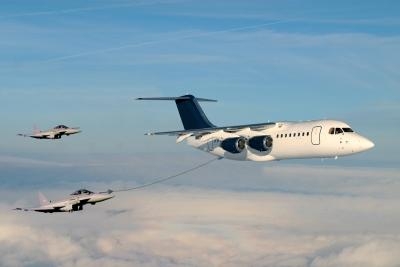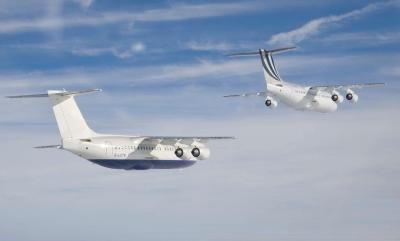Previously-Flown Aircraft Would Provide The Basis For The Conversions
Speaking Tuesday at the Defense Services Equipment International exhibition in London, Mark Taylor, Business Director Engineering for BAE Systems Regional Aircraft, unveiled a proposal for a cost-effective air-to-air refueling (A2R) variant of the BAe 146/Avro RJ regional jetliner.

“We believe that the A2R version of the BAe 146/Avro RJ is a sound business proposition for military planners and air forces that need this capability but who are having to face the financial realities of defense budget cutbacks," Taylor said. “Whether to provide A2R tactical tanker capability or, in particular, to provide realistic A2R training instead of using expensive existing assets, the acquisition of a fleet of these aircraft can be accomplished at a fraction of the cost of current refueling aircraft, whilst delivering excellent performance.”
Taylor said the design of the aircraft with its high wing and T-tail configuration is ideal for A2R operations. BAE Systems Regional Aircraft has already carried out proximity flight trials using a BAe 146-200, Avro RJ85 and Hawk jet trainer. This was successfully completed and confirmed that the aerodynamic environment behind the quad jet is benign and the aircraft therefore has considerable potential as an A2R aircraft for refueling a range of aircraft types and sizes. It is considered the BAe 146/Avro RJ might be particularly suitable as a tanker for tilt-rotor aircraft which can experience additional challenges when in the slipstream of some other tanker aircraft. The business has carried out design concepts for a hose and drogue unit (HDU)-based system and these included the option for additional fuel tanks within the cabin.
The standard tankage on the BAe 146/Avro RJ gives up to approximately 15,000 pounds of fuel available for transfer – sufficient for A2R training at the lowest capital cost. Additional auxiliary fuel tanks in the cabin would provide up to about 40,000 pounds of fuel available for transfer, making the aircraft a useful tactical refueling airtanker.
The airspeed range of the aircraft should provide flexibility in refueling the variety of fixed and rotary wing aircraft currently in service, BAe said. In this role the aircraft can fly up to 300 knots indicated air speed/M.072 at 31,000 ft (BAe 146) or 35,000 ft (Avro RJ).

Taylor said there is a plentiful supply of pre-owned BAe 146 and Avro RJs on the market at between $1 to $6 million depending on age, configuration and condition with a fleet average flight cycle time of around 30,000 cycles. In addition, there is a Life Extension Program available for both aircraft types that can increase this to 60,000 cycles, giving the aircraft many years of useful service, especially at the lower utilization levels typically flown by military and special role operators.
Lead times are short so service availability can be relatively quick and BAE Systems Regional Aircraft estimates that from go ahead it will take some 18 months to produce a basic specification centerline HDU equipped aircraft available for flight trials.
The standard fit on an Avro RJ85 would include auxiliary fuel tanks, a centerline HDU, lights, cameras and control systems on the flight deck and military communications. Pricing for a completed aircraft will be very competitive. As an example, a late model RJ85 will be around US$ 5 million for a basic aircraft with perhaps £5-10 million (approximately $8 to $16 million) of conversion costs depending on final specification. Optional fits on the aircraft could include a dual HDU installation, defensive aids (missile protection, flight deck armor and fuel tank inerting) and unpaved runway operations.
(Images provided by BAe)
 ANN's Daily Aero-Term (04.26.24): DETRESFA (Distress Phrase)
ANN's Daily Aero-Term (04.26.24): DETRESFA (Distress Phrase) Aero-News: Quote of the Day (04.26.24)
Aero-News: Quote of the Day (04.26.24) ANN's Daily Aero-Term (04.27.24): Direct
ANN's Daily Aero-Term (04.27.24): Direct ANN's Daily Aero-Linx (04.27.24)
ANN's Daily Aero-Linx (04.27.24) Aero-News: Quote of the Day (04.27.24)
Aero-News: Quote of the Day (04.27.24)




